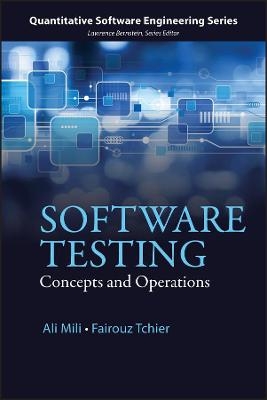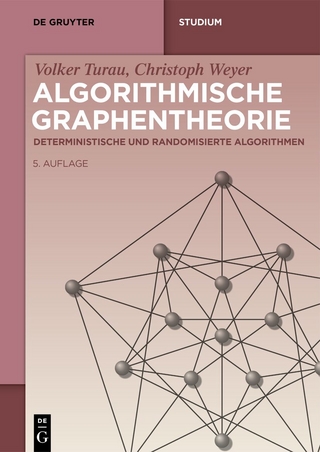
Software Testing
John Wiley & Sons Inc (Verlag)
978-1-118-66287-8 (ISBN)
Explores and identifies the main issues, concepts, principles and evolution of software testing, including software quality engineering and testing concepts, test data generation, test deployment analysis, and software test management
This book examines the principles, concepts, and processes that are fundamental to the software testing function. This book is divided into five broad parts. Part I introduces software testing in the broader context of software engineering and explores the qualities that testing aims to achieve or ascertain, as well as the lifecycle of software testing. Part II covers mathematical foundations of software testing, which include software specification, program correctness and verification, concepts of software dependability, and a software testing taxonomy. Part III discusses test data generation, specifically, functional criteria and structural criteria. Test oracle design, test driver design, and test outcome analysis is covered in Part IV. Finally, Part V surveys managerial aspects of software testing, including software metrics, software testing tools, and software product line testing.
Presents software testing, not as an isolated technique, but as part of an integrated discipline of software verification and validation
Proposes program testing and program correctness verification within the same mathematical model, making it possible to deploy the two techniques in concert, by virtue of the law of diminishing returns
Defines the concept of a software fault, and the related concept of relative correctness, and shows how relative correctness can be used to characterize monotonic fault removal
Presents the activity of software testing as a goal oriented activity, and explores how the conduct of the test depends on the selected goal
Covers all phases of the software testing lifecycle, including test data generation, test oracle design, test driver design, and test outcome analysis
Software Testing: Concepts and Operations is a great resource for software quality and software engineering students because it presents them with fundamentals that help them to prepare for their ever evolving discipline.
ALI MILI is Professor at New Jersey Institute of Technology, USA. His research is focused on software engineering, including technical and organizational aspects, and on software engineering education. FAIROUZ TCHIER is Associate Professor at King Saud University, Saudi Arabia. Her main areas of research are discrete mathematics, theoretical computer science, software engineering, and fuzzy theory.
Preface xiv
Part I Introduction to Software Testing 1
1 Software Engineering: A Discipline Like No Other 3
1.1 A Young, Restless Discipline 3
1.2 An Industry Under Stress 5
1.3 Large, Complex Products 5
1.4 Expensive Products 7
1.5 Absence of Reuse Practice 9
1.6 Fault-Prone Designs 9
1.7 Paradoxical Economics 10
1.7.1 A Labor-Intensive Industry 10
1.7.2 Absence of Automation 11
1.7.3 Limited Quality Control 11
1.7.4 Unbalanced Lifecycle Costs 12
1.7.5 Unbalanced Maintenance Costs 12
1.8 Chapter Summary 13
1.9 Bibliographic Notes 13
2 Software Quality Attributes 14
2.1 Functional Attributes 15
2.1.1 Boolean Attributes 15
2.1.2 Statistical Attributes 15
2.2 Operational Attributes 17
2.3 Usability Attributes 18
2.4 Business Attributes 19
2.5 Structural Attributes 20
2.6 Chapter Summary 21
2.7 Exercises 21
2.8 Bibliographic Notes 22
3 A Software Testing Lifecycle 23
3.1 A Software Engineering Lifecycle 23
3.2 A Software Testing Lifecycle 27
3.3 The V-Model of Software Testing 32
3.4 Chapter Summary 33
3.5 Bibliographic Notes 34
Part II Foundations of Software Testing 35
4 Software Specifications 37
4.1 Principles of Sound Specification 38
4.1.1 A Discipline of Specification 38
4.2 Relational Mathematics 39
4.2.1 Sets and Relations 39
4.2.2 Operations on Relations 39
4.2.3 Properties of Relations 41
4.3 Simple Input Output Programs 42
4.3.1 Representing Specifications 42
4.3.2 Ordering Specifications 46
4.3.3 Specification Generation 48
4.3.4 Specification Validation 53
4.4 Reliability Versus Safety 60
4.5 State-based Systems 61
4.5.1 A Relational Model 62
4.5.2 Axiomatic Representation 64
4.5.3 Specification Validation 70
4.6 Chapter Summary 72
4.7 Exercises 72
4.8 Problems 76
4.9 Bibliographic Notes 78
5 Program Correctness and Verification 79
5.1 Correctness: A Definition 80
5.2 Correctness: Propositions 83
5.2.1 Correctness and Refinement 83
5.2.2 Set Theoretic Characterizations 85
5.2.3 Illustrations 86
5.3 Verification 88
5.3.1 Sample Formulas 89
5.3.2 An Inference System 91
5.3.3 Illustrative Examples 94
5.4 Chapter Summary 98
5.5 Exercises 99
5.6 Problems 100
5.7 Bibliographic Notes 100
6 Failures, Errors, and Faults 101
6.1 Failure, Error, and Fault 101
6.2 Faults and Relative Correctness 103
6.2.1 Fault, an Evasive Concept 103
6.2.2 Relative Correctness 104
6.3 Contingent Faults and Definite Faults 107
6.3.1 Contingent Faults 107
6.3.2 Monotonic Fault Removal 109
6.3.3 A Framework for Monotonic Fault Removal 114
6.3.4 Definite Faults 114
6.4 Fault Management 116
6.4.1 Lines of Defense 116
6.4.2 Hybrid Validation 118
6.5 Chapter Summary 121
6.6 Exercises 122
6.7 Problems 123
6.8 Bibliographic Notes 124
7 A Software Testing Taxonomy 125
7.1 The Trouble with Hyphenated Testing 125
7.2 A Classification Scheme 126
7.2.1 Primary Attributes 127
7.2.2 Secondary Attributes 131
7.3 Testing Taxonomy 136
7.3.1 Unit-Level Testing 136
7.3.2 System-Level Testing 138
7.4 Exercises 139
7.5 Bibliographic Notes 140
Part III Test Data Generation 141
8 Test Generation Concepts 143
8.1 Test Generation and Target Attributes 143
8.2 Test Outcomes 146
8.3 Test Generation Requirements 148
8.4 Test Generation Criteria 152
8.5 Empirical Adequacy Assessment 155
8.6 Chapter Summary 160
8.7 Exercises 161
8.8 Bibliographic Notes 162
8.9 Appendix: Mutation Program 163
9 Functional Criteria 165
9.1 Domain Partitioning 165
9.2 Test Data Generation from Tabular Expressions 171
9.3 Test Generation for State Based Systems 176
9.4 Random Test Data Generation 184
9.5 Tourism as a Metaphor for Test Data Selection 188
9.6 Chapter Summary 190
9.7 Exercises 190
9.8 Bibliographic Notes 192
10 Structural Criteria 193
10.1 Paths and Path Conditions 194
10.1.1 Execution Paths 194
10.1.2 Path Functions 196
10.1.3 Path Conditions 201
10.2 Control Flow Coverage 202
10.2.1 Statement Coverage 202
10.2.2 Branch Coverage 204
10.2.3 Condition Coverage 207
10.2.4 Path Coverage 209
10.3 Data Flow Coverage 214
10.3.1 Definitions and Uses 214
10.3.2 Test Generation Criteria 217
10.3.3 A Hierarchy of Criteria 220
10.4 Fault-Based Test Generation 220
10.4.1 Sensitizing Faults 221
10.4.2 Selecting Input Data for Fault Sensitization 225
10.4.3 Selecting Input Data for Error Propagation 227
10.5 Chapter Summary 228
10.6 Exercises 229
10.7 Bibliographic Notes 232
Part IV Test Deployment and Analysis 233
11 Test Oracle Design 235
11.1 Dilemmas of Oracle Design 235
11.2 From Specifications to Oracles 238
11.3 Oracles for State-Based Products 242
11.3.1 From Axioms to Oracles 243
11.3.2 From Rules to Oracles 244
11.4 Chapter Summary 250
11.5 Exercises 251
12 Test Driver Design 253
12.1 Selecting a Specification 253
12.2 Selecting a Process 255
12.3 Selecting a Specification Model 257
12.3.1 Random Test Generation 257
12.3.2 Pre-Generated Test Data 263
12.3.3 Faults and Fault Detection 266
12.4 Testing by Symbolic Execution 269
12.5 Chapter Summary 274
12.6 Exercises 275
12.7 Bibliographic Notes 279
13 Test Outcome Analysis 280
13.1 Logical Claims 281
13.1.1 Concrete Testing 281
13.1.2 Symbolic Testing 282
13.1.3 Concolic Testing 283
13.2 Stochastic Claims: Fault Density 284
13.3 Stochastic Claims: Failure Probability 287
13.3.1 Faults are Not Created Equal 287
13.3.2 Defining/Quantifying Reliability 289
13.3.3 Modeling Software Reliability 291
13.3.4 Certification Testing 294
13.3.5 Reliability Estimation and Reliability Improvement 295
13.3.6 Reliability Standards 299
13.3.7 Reliability as an Economic Function 300
13.4 Chapter Summary 307
13.5 Exercises 308
13.6 Problems 310
13.7 Bibliographic Notes 310
Part V Management of Software Testing 311
14 Metrics for Software Testing 313
14.1 Fault Proneness 314
14.1.1 Cyclomatic Complexity 315
14.1.2 Volume 316
14.2 Fault Detectability 317
14.3 Error Detectability 320
14.4 Error Maskability 323
14.5 Failure Avoidance 324
14.6 Failure Tolerance 326
14.7 An Illustrative Example 327
14.7.1 Cyclomatic Complexity 327
14.7.2 Volume 328
14.7.3 State Redundancy 328
14.7.4 Functional Redundancy 328
14.7.5 Non-injectivity 329
14.7.6 Non-determinacy 329
14.7.7 Summary 330
14.8 Chapter Summary 330
14.9 Exercises 331
14.10 Bibliographic Notes 332
15 Software Testing Tools 333
15.1 A Classification Scheme 333
15.2 Scripting Tools 334
15.2.1 CppTest 334
15.2.2 SilkTest 335
15.3 Record-and-Replay Tools 336
15.3.1 TestComplete 336
15.3.2 Selenium IDE 337
15.4 Performance-Testing Tools 338
15.4.1 LoadRunner 338
15.4.2 Grinder 339
15.4.3 QF-Test 340
15.4.4 Appvance PerformanceCloud 340
15.4.5 JMeter 341
15.5 Oracle Design Tools 342
15.5.1 JUnit 342
15.5.2 TestNG 343
15.6 Exception Discovery 343
15.6.1 Rational Purify 343
15.6.2 Astree 344
15.7 Collaborative Tools 345
15.7.1 FitNesse 345
15.8 Chapter Summary 345
16 Testing Product Lines 347
16.1 PLE: A Streamlined Reuse Model 347
16.2 Testing Issues 351
16.3 Testing Approaches 353
16.4 Illustration 354
16.4.1 Domain Analysis 354
16.4.2 Domain Modeling 356
16.4.3 A Reference Architecture 359
16.4.4 Domain Implementation 360
16.4.5 Testing at Domain Engineering 365
16.4.6 Testing at Application Engineering 369
16.5 Chapter Summary 372
16.6 Exercises 372
16.7 Problems 372
16.8 Bibliographic References 373
Bibliography 374
Index 377
| Reihe/Serie | Quantitative Software Engineering Series |
|---|---|
| Verlagsort | New York |
| Sprache | englisch |
| Maße | 160 x 241 mm |
| Gewicht | 671 g |
| Themenwelt | Mathematik / Informatik ► Informatik ► Software Entwicklung |
| Technik ► Elektrotechnik / Energietechnik | |
| ISBN-10 | 1-118-66287-3 / 1118662873 |
| ISBN-13 | 978-1-118-66287-8 / 9781118662878 |
| Zustand | Neuware |
| Haben Sie eine Frage zum Produkt? |
aus dem Bereich


